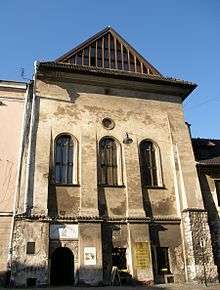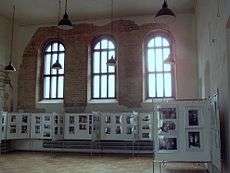High Synagogue (Kraków)
High Synagogue is an inactive Orthodox Jewish synagogue in Kazimierz District of Kraków, Poland. It was called the High (or Tall) Synagogue for many centuries for it was the tallest synagogue in the city, or because the prayer hall was upstairs. In the second half of the 16th century, a wealthy merchant known only as Israel, proposed to King Sigismund II August his request for permission to set up a synagogue. He obtained the agreement and in 1563 he started construction. Other sources state the construction date to the years 1556-1563. According to one hypothesis, the synagogue was built by emigrants - Sephardic Jews, perhaps from Greece or Italy. It appears to be in a Renaissance manner with certain modifications common north of the alps (most notably the tracery, which resembles that of St-Pierre in Caen). It was the third synagogue to be erected in Kazimierz. The prayer rooms were located on the second floor above the ground floor shops. The interior walls of the sanctuary featured paintings of scenes in Jerusalem, including the "Tomb of the Israelite Kings," "Western Wall," and a handsome pair of lions in the women's gallery.[1][2]
| High Synagogue | |
|---|---|
 Synagogue with stonework exposed  .jpg) | |
| Religion | |
| Affiliation | Orthodox Judaism |
| Status | Inactive synagogue |
| Location | |
| Location | Jozefa 38 St., Kazimierz, Kraków, Poland |
| Architecture | |
| Completed | 1563 |
World War II history
During the occupation of Poland in World War II, Nazis stripped the interior of all furnishings. However the seventeenth-century baroque chanukah candlestick, which was transported to Wawel castle, is the only element of the equipment of the synagogue that survived the war. Currently, it is on permanent exhibition in the Old Synagogue at ulica Szeroka 24. The ceiling and roof altered after the war, adding another storey above the synagogue. At present only the stone niche for the Aron Kodesh and the wall-paintings uncovered early in the 21st century by art conservation remain. On the eastern wall there is the largest and at the same time the oldest Renaissance Aron ha-kodesh in Poland, the framework probably coming from the end of the sixteenth century, and the capstone from the late eighteenth century. Above the rectangular frame is a grotesque ornament in the form of two griffins, which formerly held the crown and the Hebrew inscription of Keter Torah, which means the crown of the Torah. The cavity is bordered by channeled pillars with composite capitals. During the conservation works, in 1971-1972, painted heavy curtains were discovered on the sides of the pillars, which disappeared over time.
The High Synagogue serves as a Landmark Conservation building. Since 2005 it has been open to visitors. Photographic and other exhibitions about customs and traditions of the Jewish community of the interwar period are staged indoors.[3]
High Synagogue (Prague) was modelled after the Krakow`s High Synagogue.
See also
- Oldest synagogues in the world
- Synagogues of Krakow
- Remuh Synagogue
- Tempel Synagogue
- Old Synagogue (Krakow)
- Izaak Synagogue
- Wolf Popper Synagogue
- Kupa Synagogue
References
- Rabbi Eliezer Gurary, Krakow High Synagogue WEJEW Mediashare Community, 2008 New Israel Media L.P.
- Rebecca Weiner, High or (Tall) Synagogue The Virtual Jewish History Tour
- The Jewish Krakow, The High Synagogue: ul. Jozefa 38 Archived 2008-09-07 at the Wayback Machine
External links

- Virtual tour at YouTube.com